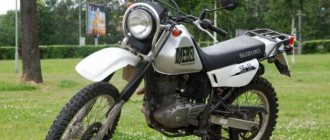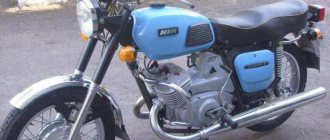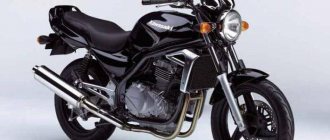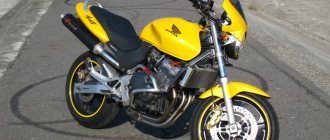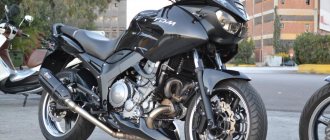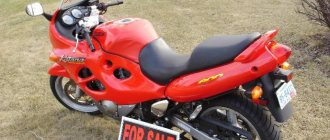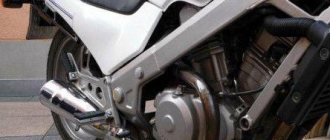The Suzuki Skywave 400 maxiscooter was one of the first vehicles in its class that changed the way users thought about travel motorcycles. There is another modification of this model called Burgman 400. It belongs to the category of business class maxi scooters.
Skywave 400 was appreciated by drivers in our country. High technical characteristics and comfortable operation allowed the scooter to become in demand. What is Skywave 400? We will talk about this in detail in the article.
Story
Starting our review of the Suzuki Skywave 400, it is necessary to talk about the history of the creation and development of the presented model. It appeared on the motorcycle market in 1998. The size of this vehicle was superior to its analogues. Thanks to the design features, it was possible to give the scooter comfort and maneuverability while maintaining good load capacity.
The first model had a wheel size of 159 cm. It was comparable to the overall characteristics of full-size motorcycles. The model was developed for long trips on the highway. In urban areas it also remains quite maneuverable. The developers have provided the model with good wind protection and a spacious trunk.
In 2001, the Skywave 400 underwent some design changes. The headlights, rear part and seat dimensions began to differ from the first variation. The design also changed in 2003. At the same time, the developers paid attention to the engine. He received an engine with a fuel injection system.
Test drive HondaSilver Wing 400, SuzukiSkyWave 400
The idea to test three Japanese 400cc scooters in one test came to us quite a long time ago. Once, at the end of 2008, we even tried to do this. But, as luck would have it, then only two of the three scooters came to the test - the Yamaha Majesty 400 and the Suzuki Skywave 400. The third, absent, was the Honda Silver Wing 400. Perhaps this was for the best... for the other two test participants.
Honda Silver Wing 400 is the only maxi scooter of this volume that is equipped with a two-cylinder engine. Its maximum power and torque figures are the most impressive of the Japanese trio. And the engine layout itself is significantly different. For example, in Yamaha and Suzuki, the engine-wheel unit is inseparable, as is the case on smaller scooters, including fifty-kopeck scooters. Honda initially took a different path. Back in 2001, when it launched the Silver Wing 600 model, it separated the variator from the engine, securing the latter in a motorcycle style - inside a spatial tubular frame. A similar scheme with some improvements was later used in its competitor – the Suzuki Burgman (Skywave) 650 maxi-scooter. But, let’s return to the subject of our test. The Honda Silver Wing 400 was released much later than the older model, only in 2006, and, not counting the engine size, is an almost exact copy of it.
Due to the fact that work on optimizing the weight of the first 400 was not carried out (only three years later the second, significantly modified model SW-T400 was released), the scooter weighs only slightly less than the 600 cc model and significantly more than its competitors . Therefore, its advantage over them in the form of greater power and torque, in theory, can only equalize its speed and dynamic characteristics on the road with less powerful, but lighter scooters. But is this true in practice? This question tormented me for two long years, until we had a new opportunity to test this model. It all started with a call the editor received from Nastya, the owner of a Suzuki Skywave 400, which I managed to dub “fluffy” during the test. The proposal to test a single scooter did not arouse much interest, and therefore on the same day we found the Honda Silver Wing 400 as a test competitor. Its owner Alexander, apparently, did not mind seeing his favorite quickly make short work of the white and fluffy Skyway " Although his expectations were largely justified, I’ll tell you honestly, no one came out of this fight as the sole winner.
Suzuki, when creating its scooter, tried to take into account all the needs of its potential buyers, and therefore the scooter left the design bureau completely self-sufficient. It has everything that could be useful for a metropolitan resident who travels daily from home to work and back. And for longer trips the scooter is quite suitable. After all, in its huge trunk, located under the seat, a tent, sleeping bag, sleeping mat, and also skewers can easily fit - tested with my own hands!
In terms of ease of riding, the Skywave will significantly surpass most motorcycles, with the rare exception of touring models. But this is a completely different weight (and price) category. Like most other “sofas,” the Skywave has the option of stretching your legs forward or placing them on wide platforms in a semi-bent position. However, the same applies to its competitor – Silver Wing. But for a person of my height (180 cm) or taller, Silver turns out to be more comfortable in terms of fit. Both scooters have an adjustable passenger backrest, but the Honda can be moved back a little further than the Suzuki.
The Silver Wing 400's luggage capacity seems every bit as big as its competitor's. Two helmets and many other small items fit under the seat, and the left glove compartment at the steering wheel holds a liter of Pepsi or a couple of cans of beer. In the same glove compartment there is a 12-volt car socket.
The test Silver Wing 400 was equipped with Givi tuning touring glass, which was significantly larger in area and height than the standard one, as well as side deflectors that diverted the oncoming air flow from the driver’s feet. All this made it possible to completely protect the driver from the headwind, and provided a significant advantage over the competitor during sea trials. For example, at a speed of 80-100 km/h the driver is completely in an air pocket, which allows him to remain dry for a long time when driving on the highway in the rain.
Skywave as standard does not protect the driver from wind and bad weather as well. Although a few accessories, if desired by the owner, will allow this to be corrected. On our test subject, at a similar speed of 80-100 km/h, the wind flow hit both the helmet and the shoulders. Again, I note that this is the case with a driver of my height (180 cm). This is the second time we have tested the Japanese version of this scooter. And I had the assumption that both its ergonomics and wind protection were adjusted to the size of the Japanese, who are much shorter than Europeans. But without a “confrontation” with the European model Burgman 400, I cannot confirm the correctness or incorrectness of these judgments.
When driving around the city and on the highway, both scooters showed their positive and negative sides. There is no big difference in the dynamics of acceleration from 0 to 60 km/h between them, but after this mark the Skywave loses its agility, while the Silver Wing continues to accelerate briskly up to the 120 mark. And this is without turning on the T-mode, which can be activated on the Silver Wing with a button on the handlebar. When it is turned on, the engine control unit changes the injection map and maintains higher engine speeds, which provides faster acceleration. True, a side effect of turning on this mode is increased fuel consumption, and therefore it is not worth using it very often. When using the scooter in the city, the engine power is quite enough.
A more significant difference in the operation of the engines of these “sofas” is determined by their design. The single-cylinder Skywave cannot be expected to respond as quickly to opening the throttle as the Silver's two-cylinder in-line engine. That is why the scooter from Honda is very reminiscent of the “sporty” Yamaha T-MAX, the in-line “two-piece” of which spins just as quickly. Skywave, on the contrary, loves low and medium speeds and leisurely driving.
But due to its much lighter weight, Skywave handles much better than its competitor. It's easier to maneuver into a tight corner or a bunch of corners, and requires little to no effort to keep the scooter upright when riding at walking speeds, such as in traffic jams. In terms of handling, the Honda is the complete opposite. “Silver” resists putting it into a sharp turn or a sharp change in trajectory at high speed, and all the time strives to “stand up” and straighten the trajectory. At low speeds, on the contrary, it is a roll. This is a sign not only of greater weight, but also of a higher center of gravity. On the other hand, the weight of the scooter has a positive effect on the comfort of driving on our roads. Over bumps, including those thrown under its wheels in corners, it remains surprisingly stable. The suspension clearly handles holes and protrusions of the asphalt, transferring only a small part of the outstanding impact energy to the steering wheel and body of the scooter. To a greater extent, such good suspension performance on this scooter was achieved thanks to the design features of the engine and rear suspension, which were mentioned at the beginning of the article.
On Skywave, the large unsprung mass in the form of an “engine-wheel” block does not allow the rear suspension to handle all the bumps as clearly. And the plug does not have the same energy intensity as a similar unit on Silver. Therefore, it happens that both the front and rear wheels are thrown into the air on large uneven surfaces, sensitive shocks are transmitted to the steering wheel, and in turns there are also lateral vibrations. In addition, the driver does not feel a clear connection between the wheels and the road surface, and therefore does not have the same sense of confidence when piloting a scooter that the Silver Wing driver has.
The combined braking systems of both scooters work almost identically. And only the Silver’s separate front brake brakes better. This can be explained very simply: it has a three-piston combined caliper installed in front, in which two pistons are activated when the front brake lever is pressed. Skywave has only a two-piston combined caliper at the front, which means that only one piston operates from the right lever (it should be remembered that they are of different diameters and from the left lever, which operates the rear brake, a smaller piston is activated in the front). Although, if you forget about how to brake on a motorcycle (and this must be done on a scooter) and fit into the image of a typical “sofa driver,” then you don’t have to press the right brake handle at all. The left lever, responsible for combined braking, can fully satisfy the driver’s needs with a leisurely driving style. The last statement can also be applied to “Silver”. You just have to press the lever a little harder, because with the same braking power, the weight of the scooter is greater, and the initial moment of braking is not as sharp as that of the Skywave.
It turns out that each of these two scooters has its own advantages and disadvantages. Weight, power, and handling can only be considered ideal when they are balanced. But in our case, one helps and the other harms. Silver Wing is heavy, but more powerful. Its perky character will definitely appeal to those who want sporty features in their scooter. In addition, many may like the complete external resemblance to the older model. Skywave is a little less comfortable, but no less popular in our country due to its significantly lower cost on the secondary market. But I don’t agree with Alexander’s opinion that the Skywave is a “girly” scooter just because it is lighter and smaller in size. Real men can appreciate these benefits too. Unless they have to remove the “skin” from the seat...
Opinion: owner of Honda Silver Wing 400, Alexander Melnik (Galun)
To be honest, at first I didn’t believe that this Skywave was a 400. It is much lighter and smaller than my scooter. I don’t even know if this is a plus or a minus. After all, Honda released the Silver Wing 400 and 600 in the same “body”, and from this they won in some ways, and perhaps lost in others. The Skywave's lighter weight and size make it... "girly" or something... This scooter is much easier to control and, in case of a fall, easier to pick up. But let's get back to the boring stuff - the characteristics. It's hard to judge the acceleration because my Silver Wing has a Multivar and a stiffer torque spring. And the behavior on the road is greatly influenced by the weight of the device. “Silver” is heavier, and this makes it more stable. And for me this is an advantage. According to my subjective feelings, “Silver” is more disruptive, holds the road better, and the presence of the “all money” button gives it an additional advantage when overtaking.
But since the Skywave I had a chance to ride is “fluffy,” this compensated for all its shortcomings.
Thank you for providing the scooters for testing.
Anastasia Bronnikova and Alexander Melnik (Galun)
Text: Vladislav Sofonov
Photo: Andrey Shlenchak
Appearance
The Suzuki Skywave 400 maxi-scooter has a beautiful, modern design. It harmoniously combines smooth lines with optimal color schemes for this group of vehicles. The design is designed in the same style.
The appearance of the Skywave 400 resembles a sports motorcycle. This is facilitated by the aggressive, powerful shape of the fairings. The shape of the seat is noted by users as comfortable. Traveling on this scooter will be convenient even for two people. The backrest can be moved. There are three provisions.
The trunk is roomy. Its volume is 55 liters. It easily fits both helmets, as well as small things that the driver may need on the road. The trunk is equipped with a light bulb that allows you to illuminate the space inside.
The load capacity of the model is 200 kg. This is a good indicator for motorcycles of this class. The new models are not without external respectability. The design was thought out by the creators in every detail.
Appearance of a maxi scooter from Suzuki
The harmony of lines and color schemes never ceases to amaze. Everything is created in the same style. Plastic fairings give the impression that this is an aggressive sports bike. Comfortable seating allows two people to travel without discomfort. The backrest can be used in three positions. The large 55-liter trunk allows you to place not only two helmets, but also some luggage. In addition, there is a light that makes using the trunk more convenient. Load capacity is at least 200 kg.
Specifications
When considering the technical characteristics of the Suzuki Skywave 400, it is necessary to note a number of mandatory indicators. They allow us to draw conclusions about the operating features of the presented vehicle.
The engine capacity is 400 cm³. At the same time, the engine power reaches 33 hp. With. It has one cylinder. The engine belongs to the category of four-stroke varieties. The scooter is capable of reaching speeds of up to 150 km/h. This is the maximum threshold.
Gasoline consumption at average load is 4-5 liters per 100 km. The fuel tank volume is 13.5 liters. The gearbox belongs to the CVT category. The dimensions of the vehicle are quite large. The scooter has dimensions of 76x137.5x226 cm. At the same time, its weight is 225 kg. The presented characteristics meet all modern requirements for vehicles of the presented class.
Review of the model based on three years of experience in owning it. I’ve been wanting to write for a long time and finally gathered the courage and forced myself to do it. The post will not contain lyrics about my childhood in the early 1990s, “how I came to live like this” and other nonsense that is of no interest to anyone. Fortunately, this is not the first season, not the first vehicle, not the first 30 km of run.
We welcome everyone who is interested in choosing a maxi-scooter and, in particular, the Suzuki Skywave (Burgman) 400 model.
Brief technical information. Engine: 4-stroke, 1 cylinder, water cooled, SOHC. Volume: 385 cm³. Power: 36 hp Dry weight: 184 kg. Fuel tank volume: 13 l. Trunk volume: 56 l.
For reference: Skywave and Burgman have no technical differences. Sky is the name for the domestic Japanese market, Burg for the European market. Actually, from the name it’s clear where the device used to run, but what’s the point? I specifically have a K2 - 2002 model year, popularly nicknamed “the asshole.” It differs from K1 only in appearance; injection versions began with K3. As I learned later from competent people, the “anniversary series”: two-tone body paint (white and gray in my case), gold nameplates instead of silver, and full equipment in the base (heated handles, windproof mugs, etc.).
I bought it in April 2011, with about 26 thousand miles on it, now it’s more than 46 thousand. Moreover, the mileage was probably twisted: well, I don’t believe in such mileages even for a maxi-scooter at 9 years of age. I've ridden it for three seasons and more than 20 thousand kilometers. During this time, I went twice to a long distance “to the seas and mountains”, periodically to the dacha, and the rest around the city. I use it mercilessly during the season, in workhorse mode - every day. I don’t have (and don’t need) a car or other transportation. In a day in the city and traffic jams, I can easily cover up to 200 km. At the dacha, I calmly go along country paths to the rivers and lakes for swimming and fishing. In the south, I also did not deny myself the pleasure of climbing a mountain in it, even where only quadrics and UAZs drive. Based on this experience, I share my impressions. And they, it should be noted, are still beautiful! Although there are a couple of disadvantages, rather not even disadvantages, but what is now missing for me personally. But everything is in order.
1. Comfortable! This parameter for this model is beyond praise! It’s not for nothing that they are called “sofas on wheels.” It is in terms of convenience that many are jealous for good reasons, despite the more powerful and cooler motorcycles of their own. I even read in the article:
Suzuki was the first company in the world to release a model that gave rise to a whole class of motorcycles. We are talking about a business-class maxi-scooter, the Suzuki Burgman 400. Previously, it was believed that the most comfortable motorcycles were cruisers. That was until the introduction of the Suzuki Burgman 400. This is the motorcycle that revolutionized the concept of maxi-scooter travel.
And it is true!
Excellent comfort consists of a number of things: the driver’s backrest is adjustable for reach, a large soft saddle, the ability to stretch your legs forward, like on cruisers - they provide a very comfortable and relaxed fit, in which nothing becomes numb and does not get tired no matter how much time you spend behind the wheel. - like on a sofa. When I went on a long journey with it, I was very surprised and pleasantly pleased: on the first day I drove 1,100 km. from Moscow to Rostov-on-Don and cried as if I hadn’t ridden all day at all, no fatigue either in the lower back, or in (for some reason) the unrestrained butt, or in anything else. If it weren’t for the darkness and the need to sleep, I wouldn’t have stopped at all. On the second day, I completed the remaining 700 km with the same ease, and fatigue never accumulated. Plus a large windshield (stock, without the need to buy any additional travel options), behind which you can smoke for a hundred, large mugs on the steering wheel and a streamlined body that covers the legs both in front and below - all this reliably protects from wind, splashes and light rain. The aerodynamics of the motorcycle create an air bubble, thanks to which the pilot does not feel the headwind, and raindrops are blown back behind the pilot, so that in light rain you remain dry even without a raincoat. Pluses to comfort are added by large platforms under the passenger’s feet, on which the entire leg fits, the passenger’s backrest and large, comfortable handles - the passenger feels no less comfortable, and sitting above the pilot on an equally sized part of the sofa, he also has a good view in all directions . By the way, when I was choosing what to buy, this was also what took me away from the Honda Silver with its small folding legs for the passenger. The capacity of the trunk, in my opinion, is also an argument for the comfort of the motorcycle. The underseat space is 56 liters - in addition to the fact that a music amplifier is installed there, it can easily fit two helmets, a tool box, a liter bottle of oil, a motorcycle cover, a chain, two jackets, two pairs of gloves, every little thing... and that's not all stuffing nothing inside helmets! Plus, in front there is also a rather large glove compartment with a key, and a couple of small ones that cannot be locked (I have built-in speakers instead). It is also possible to add a trunk, and what’s valuable is that the passenger backrest and trunk are not removed, so the volume easily increases to over one hundred liters, and if you also hang side bags... you can drag half the house with you and completely forget about your place of registration :) )
Bag with laptop (14″), bag with large SLR camera, tripod, 2 x 2.5 l. beer, 3 kg of pasta, 2 bottles of butter, a bottle of ketchup, a can of canned food, a box of tools.
There is no need to talk about heated handles separately as a plus of comfort - now you can install them on everything. Except for the fact that these are original factory pens that come as standard. I’ll simply say: with its wind and cold protection, I calmly drive to the snow - the temperature outside doesn’t bother me: as long as there is no precipitation and a dry, ice-free road. 11/11/2013, overboard +3.
2. Reliability. This is the second song that can be sung about Sky-Burgie. Yes, with any equipment there are breakdowns, etc., but I will say this: for three seasons and more than 20 thousand km. Nothing in the bike itself was broken. Even the variator belt is still like new, although I haven’t changed it at all and it’s unknown how long the previous owner ran on it. I changed the clutch bell in the variator twice, the first time with a used one, which was already worn out, so it outlived its usefulness during the season and was replaced again with a new one the next season. On long drives during long drives, in the city through traffic jams in the heat, at the dacha through the fields - nothing has ever broken.
The service center did a complete overhaul of the engine: some guys I knew suggested doing it as a preventive measure. There were no prerequisites or necessity for this, simply arguing that it was still necessary to look at the internal state of the 11-year-old motorcycle. They took it apart with me, the first thing they said was: “Apparently, we are the first in 11 years to disassemble it at all since it left the factory!” At the same time, the condition is ideal! Everything is like new, nothing requires maintenance or replacement. As a result, we cleaned off the small burnt on the valves with a blade and changed the rubber valve stem seals and oil seal, and that was simply because I had already bought new ones in advance. So all the time I spend only on consumables: mainly oil and tires. I changed the brake pads once. In the boiler, the oil is changed once after winter (less than half a liter). Also, once after winter, the oil filter and all the oil in the engine (1.7 liters) are changed, but it is constantly topped up, because scabies love to eat oil and you need to constantly monitor the level.
3. Controllability, maneuverability, maneuverability. As I wrote above, thanks to the comfort of driving this vehicle, you don’t get tired at all, regardless of the travel time and number of kilometers. Ease of control undoubtedly plays a role in this. Wide steering wheel with a comfortable grip for me (with my height 187 cm). For example, I don’t like the steering wheel on the popular SV cars at all: I have to clench my hands more tightly, which results in stiffness. The low center of gravity, stability and balance make it easier to control than a bicycle, even at walking speed; in principle, you don’t have to hold the steering wheel (which sometimes blatantly scares girls :) ). At the same time, the dimensions make it easy to climb into any cracks in traffic jams, where mostly only small nuts and crunches fit. Many people lag behind me in heavy traffic jams, even the “big brother” 650 Burg. Cross-country ability: it is clear that, in principle, the purpose of this class is the city and asphalt. It is not suitable for swamps and shit, but at the same time it is not difficult for it to drive along a dirt road, even with mud - with its stability, low overall weight and low center of gravity, it is easily held. At the dacha there is no problem going to the river to swim or to the lakes to go fishing. The only thing is that you have to be careful on the grass, especially on wet grass when there is dew or after rain - your ass is itching, like a girl of easy virtue :)) Although the problem was solved by winter tires with a tractor tread pattern on the rear wheel. By the way, I really liked it - it made the motorcycle even easier to maneuver and controlled better. The only downside is its softness - it wore out in 10 thousand km.
Well, and finally, a ladle of ointment into this sugary-sweet barrel - the cons and disadvantages. There is only one serious technical disadvantage: scabies eats oil!!! And don’t believe salesmen who swear and swear that their equipment does not burn oil, and whoever says the opposite is a loser and should put their equipment in order. By the way, this is a good trick to check from which vendors the device is being purchased: ask what kind of oil was filled in and how often. This is a feature of scabies (650 Burg does not have this). For every 1000 km of mileage, 100 to 300 ml of oil is normal. In this regard, you need to constantly monitor the oil level, although this is not difficult: unscrew the dipstick, look, top it up if necessary, and go. But the downside is that, firstly, you need to constantly remember this and make it a habit that every trip begins with checking the level. God forbid you leak the oil: at the service center, the same guys I knew gave me a tour of the “engine graveyard” and scared me with horror stories of “what happens when you leak ... oil”: there is a big threat of replacing the engine as a whole. Secondly, in connection with this, you must always have a bottle of oil with you, remember, I talked about the capacity of the trunk - oil is a mandatory item on the list of things to be carried. You may not have the tool with you, but you should always have oil. Sky has no more disadvantages. There are several shortcomings that now exist for me from the height of my current experience and the fact that I have already outgrown this class. Previously, it seemed to me “fast and bold, sharp as a bullet,” but now I lack power and dynamics. When I’m traveling alone, it’s fine, but when I’m with a passenger, sometimes it gets boring. I want more acceleration, I want more dynamics after 100 mph. for greater ease and comfort of overtaking, and a little more cruising speed. For scabies 150 km/h. ceiling, but it is not recommended for the engine to drive faster than 130 km/h. Actually, in terms of comfort, it turns out the same way: my cruising speed on the highway is 120-130, for overtaking up to 140. But a long acceleration from 120 forces me to slow down, give way to many people moving in the left lane and wait for a large enough gap in the flow to safely get out and accelerate. Lovers of a calm, measured ride, without fuss and racing, will appreciate its aristocratically restrained and calm character. Although for beginners transferring from a smaller class, it will seem fast and dynamic at first, and will bring a lot of pleasure. But for them it will be a transitional temporary option until they grow into a larger class. Like me, actually, I’ve grown up a long time ago, but for my calm nature and driving style, riding it is a pleasure. I look at the larger class not for reasons of speed and racing, but from the point of view of versatility and touring. The habit of comfort has become so strongly instilled in this device that I will only exchange it for something no less comfortable: currently in my dreams is a Honda Deville NT700. Some will call the small wheels a disadvantage, but we must remember that this is still a maxi-scooter, not an enduro. Although I also don’t have enough big wheels so I don’t have to worry about every pothole and don’t have to slow down so much. But this is all from the evil one and the snickers - if you want more: save up and buy a larger class. And for its class, this is the most comfortable, reliable, roomy, crafty and beautiful sofa! I would not exchange it and would keep it forever for everyday city driving, and in addition I would take something second for tourism. But finances don’t yet allow me the luxury of keeping two, so I’ll have to sell and look for a compromise in a larger class.
A few more photos of my handsome man and a short video at the end.
Engine
The Suzuki Skywave 400 engine belongs to the class of four-stroke designs. It is equipped with a fuel injection system. This technology can significantly improve the performance characteristics of the motor. According to expert reviews, it has good dynamics indicators.
The engine design is created taking into account the possibility of starting the system in a cold state. In this case, the moving elements do not wear out. The design is designed to reduce fuel consumption. When creating it, the highest environmental requirements developed by the international community were taken into account. Exhaust gas levels are reduced by using a special catalyst and oxygen return system.
The engine is cooled using liquid. The motor is started using an electric stator. Driving style significantly affects gas mileage. Fuel with an octane number of 92 or higher is suitable for refueling. The engine is unpretentious in terms of fuel characteristics.
Transmission
The presented model is equipped with an automatic transmission. This design is reliable during operation. The transmission, which is a continuously variable type, has a properly tuned variator. Suzuki Skywave 400, thanks to this feature of driving the vehicle, becomes more comfortable. If the driver suddenly turns the throttle sharply, the scooter will still move smoothly. This significantly improves road safety.
The main drive is of the belt type. This is the simplest and most common design. If necessary, it can be easily replaced over time. Materials and parts for such transmissions are sold almost everywhere.
When servicing the engine and transmission, it is necessary to purchase special oil. This will increase the service life of the mechanisms. The engine and transmission are reliable, durable systems.
Design features
Let's start with the impressive dimensions of the maxi scooter: length - 2270 mm; width-760mm; height-1385. It is also worth mentioning the saddle height of 710 mm, which affects the appropriate riding position. The main power unit on the maxi scooter is a four-stroke petrol engine with a displacement of 385 cc. see Number of cylinders - 1, valves - 4. The engine is powered by electronic fuel injection. If we express power in horsepower, then it is 34 units. Electronic starting and ignition system. A reliable liquid cooling system protects the motor from overheating.
The curb weight of the Japanese scooter is 222 kg. The vehicle is equipped with a steel tubular frame as a “skeleton”, which takes the load from the weight of the engine, all components of the scooter, as well as the driver and passenger. The fuel tank capacity is 14 liters, which is quite enough for long trips. All power from the engine is transmitted to the rear wheel via a belt. The gearbox is automatic and the clutch system is centrifugal. The wheels are shod with tires with a special tread for driving in urban spaces, alloy wheels.
Chassis, brakes
When studying the technical characteristics of the Suzuki Skywave 400, it is also necessary to pay attention to its chassis and brake system. The first of these systems is noted for its good development. The frame is highly rigid. At the same time, the suspension is characterized by high reliability. The design features of the chassis make it possible to maintain high vehicle controllability in almost any conditions.
If necessary, the rear suspension can be adjusted by the user independently. A special key is used for this. According to experts, the driving characteristics of this tourist model are in many ways similar to sports varieties of scooters.
The hydraulic disc brake system guarantees safe stopping. If necessary, the scooter will stop quickly. The combination of two types of brake systems gives reliability to the unit. The right lever is responsible for the front caliper, and the left one for the rear caliper. The model has the ability to lock the rear brake.
Performance characteristics
Considering the characteristics of the Suzuki Skywave 400, several more features of the presented model should be noted. It is equipped with an anti-theft mechanism. It is built into the ignition switch. A special shutter prevents the installation of a non-original key. It is also impossible to use its copy or other fake.
The difference between the original key is a special magnet. It is applied to a special place on the lock. Only after this the curtain will move back and the key can be inserted into the ignition. This is a simple but effective anti-theft system.
The seating position on the presented motorcycles can be changed according to your needs. It can be classic, chopper, etc. Some drivers note the lack of legroom. If the driver's height is more than 180 cm, some discomfort may be felt due to stiffness.
The mirrors are installed on the steering wheel. This somewhat impairs the view. However, when moving in urban environments, this is rather an advantage.
Purpose of the model
The Suzuki Skywave 400 scooter was originally designed as a vehicle designed for highway riding. The luxury model allows you to create maximum comfort when moving in highway conditions. It develops high speed, while remaining quite maneuverable and stable. Control over the system ensures high user safety.
It was not by chance that the developers created a large trunk for this model. When going on a trip, you can hide many necessary and valuable things here. Putting your equipment in the trunk will be much safer than leaving it in a backpack on your shoulders.
Returning from a trip, you can freely drive around the city highway. The scooter cannot boast of excellent maneuverability. However, this does not reduce comfort even when moving through traffic jams.
Advantages
Considering reviews of the Suzuki Skywave 400 left by motorcycle experts, it is worth noting a number of advantages of this model. The presented scooter belongs to the category of highly environmentally friendly vehicles. In terms of emissions, the unit complies with one of the highest European standards, Euro 2.
The motor operates dynamically at all speeds. The chassis is very reliable. The combined braking system adds safety to the driver on the road. The scooter seats are comfortable. This allows you to be on the road for a long time. The spacious trunk makes it possible to take all the necessary things with you on a trip.
The light system is also reliable. Stylish design and good maneuverability also distinguish the presented vehicle.
Dashboard
Modern digital sensors are located on a convenient and practical digital panel. It harmoniously accommodates the fuel level and oil heating sensor in the engine. In addition, the panel houses a speedometer and tachometer. The ignition switch is located in the center. The panel is designed in such a way that the driver can monitor the speed limit and engine speed as comfortably as possible. There are special small buzzers installed on the sides, which notify about engine failures or problems with the chassis of the maxi scooter.
Flaws
The Suzuki Skywave 400 is also not without some drawbacks. They are, however, unimportant. The positive qualities of the model completely overshadow the shortcomings. However, before purchasing, you need to know about some of the disadvantages of Skywave 400.
The dimensions of the model are quite large. It is this factor that affects the reduction in vehicle maneuverability in city driving conditions. Experts also note that there are minor errors in the manufacture of the exhaust system and rear brake. Gaskets in this system have to be replaced every 2-3 years.
During manufacturing, the manufacturer angles the windshield too far. Therefore, when using the scooter, it must be configured correctly. It should also be said that the cost of the presented model is quite high. However, it fully matches the high quality of the Skywave 400.
Price
The price of the Suzuki Skywave 400 depends on the year of manufacture of the vehicle. The first generation (1998) will cost less. However, such motorcycles are sold mainly by private owners. Therefore, there is no clearly established price for this equipment. The first generation scooter can be purchased for an amount from 70 to 110 thousand rubles.
Later versions cost a little more. So, Skywave 400 produced in 2001-2002. you can buy from 100 to 140 thousand rubles.
If you want to add dynamics to the engine, you can purchase a CVT separately. This, for example, could be the Malossi Multivar device. Its price is 6-8 thousand rubles. If you wish, replacing it yourself will not be difficult.
If the driver wants to modify the steering wheel design, this can also be done independently. The cost of such an event is about 2-4.5 thousand rubles.
Suzuki Burgman 400
The Suzuki AN400 maxi-scooter appeared in the company's production program in 1998. This two-wheeled sofa, larger than other motorcycles, successfully combines high comfort and luggage capacity with the ability to “plow through” city traffic.
It’s hard to call such a vehicle a “stool”: the wheelbase of 1590 mm is comparable to the dimensions of full-size motorcycles (for comparison, the base of the Honda ST1300 Pan-European is 1491 mm, almost 10 cm smaller). The Burg looks more like the result of crossing a touring motorcycle and a scooter.
The AN400 inherited comfort, excellent wind protection and a large volume of luggage capacity from the tourer, and the concept and partly the layout from the scooter. The transmission is, as expected, continuously variable. At the same time, the variator is configured as user-friendly as possible - so as not to scare the latter in any case if he suddenly turns the throttle too sharply. Of course, there is a leg opening typical for scooters (unfortunately, there is no completely flat floor) and a spacious “toilet”. The wheels are small, scooter-style – 13-inch both front and rear.
By 2001, Burgman was updated. First of all, the scooter, which received the K1 index, is distinguished by a modified rear design and an increased volume of the “toilet bowl”. Due to the shape of the lights, reminiscent of those of the Mercedes E-Class, it was popularly nicknamed “the asshole.” In addition, changes also affected the frame. The frame number, accordingly, also became new - CK42A.
In 2003, a new generation of Burgmans with an injection engine and a radically new design was presented to the public.
FOR WHAT?
Transport for all occasions, not without, despite belonging to the scooter tribe, a certain touch of respectability. Of course, the years take their toll, and the appearance of the first “Burgmans” can no longer be called modern, but the functionality of the device does not suffer from this.
Quite decent dynamic characteristics allow you to “nimbly” in city traffic, and thanks to the excellent wind and dirt protection, even in bad weather you feel comfortable in this “Maxi”. And the equipment requirements for the driver of a maxi-scooter, as it happens, are somewhat lower than in the case of riding a motorcycle. But the most important thing is the ability to carry a lot of luggage. Agree, the same laptop or SLR camera will be much safer in the “toilet” than in a trunk or even in a backpack on the back of a motorcyclist.
The single-cylinder, single-shaft engine, fed by a carburetor with a 36 mm diffuser, develops 32 hp. at a not quite scooter-like 8000 rpm. The 13-liter tank lasts a long time; If you don’t force the engine to work at maximum speed all the time, the consumption is 4-5 liters per 100 km.
The chassis is generally plush, and the ability to adjust the rear shock absorber does not change the situation. But this is not so necessary for a comfort-oriented “suitcase on wheels”. Moreover, the specific geometry of the device will not allow you to write a turn “on your knees”: even at what would seem to be a very far angle of inclination, the central stand or even the frame comes into contact with the asphalt. The situation is aggravated by soft suspension and a long wheelbase. But the brakes cause no complaints. Again, if we do not forget about the appointment of “Burgman”. Yes, the operation of the combined brake system has its own specifics: the left brake lever acts not only on the rear brake, but also on one of the front caliper pistons, the right lever operates only on the front brake. But in an average emergency situation, the effectiveness of such a solution is obvious.
The ignition switch has an anti-theft mechanism: a curtain closes access, preventing the use of a copy of the key or a “roll-up”. The original key contains a small magnet, which is applied to the corresponding “window” on the lock to unlock this albeit primitive, but effective mechanical protection.
The landing position on the Burgman can be varied in a fairly wide range - from almost chopper to classic. The only problem is that there is not enough space. With a height of about 180 cm, with your legs stretched out, you realize that you are sitting awkwardly between the front inclined shield and the driver’s backrest. The mirrors are located on the steering wheel, which gives slightly less visibility, but better anti-traffic.
“Burgman” feels great not only in the city - it will not be an outsider on country roads either. Moreover, nothing prevents you from taking it on a trip. And upon returning, you can continue your daily voyages along the home-work-home route just as calmly and comfortably.
WHERE TO LOOK?
There are no difficulties finding a carbureted Burgman or first-generation Skywave. There are many offers, mainly, of course, from private individuals - injection machines are already more often offered in showrooms.
If for some reason the available equipment is not satisfactory, and the budget does not include the purchase of an injection model, you can contact companies that deliver custom-made equipment from Japan. There is enough Skywave of the first generations there for now.
TUNING
In Japan, more than anywhere else, Sky suffered from tuners of all stripes. Lowriders, long-wheelbase cruisers, and almost sports cars were made from it, not to mention “Christmas trees” - with lights, spoilers and, of course, music. In Europe, tuning of the Burgman had a more functional bias - glass, trunks and, of course, improved dynamic characteristics.
If there is a lack of dynamics, the first thing to worry about is replacing the original variator with an aftermarket one. The same Malossi Multivar will dramatically transform the Max, making acceleration to hundreds much more vigorous. A new “varic” will cost 6.5-7.5 thousand rubles, replacing it yourself will not be difficult. If you have enough dynamics... just take a ride in a Burg with a tuned CVT, and questions like “why is it needed?” will disappear on their own. After replacing the variator, it is logical to worry about installing a “sports” clutch (7-8 thousand rubles), which operates at higher speeds.
You can, of course, approach the issue of increasing the dynamic capabilities (and fuel consumption) of the Maxik more radically: replace the carb with a flat throttle one, with a diffuser of a larger diameter (more details on p. 86). But the necessity of this is debatable.
“Forward flow” on “Burgman” costs from 5-7 thousand rubles. for a “can” of unknown origin up to 12-16 thousand rubles. for the "end" from Giannelli or LeoVince. Apart from sound, installing a “forward flow” will give practically nothing, except perhaps a slight reduction in weight and an increase in pomp.
The lack of rigidity of the Burg fork can be partially offset by pouring more viscous oil, as well as installing stiffer springs (3-6 thousand rubles). More global alterations - adding a traverse, replacing feathers, etc. - are hardly advisable. You still can't make a sportbike out of a scooter.
Replacing tires (for example, with Michelin Pilot Sport) can significantly improve the burg's behavior on asphalt.
The original steering wheel, firstly, is not comfortable for everyone (the handles are bent too far towards the driver), and secondly, you cannot install a bracket for a navigator or phone on it. Therefore, quite often both the steering wheel and the plastic are thrown away, replacing it with a normal aluminum one. Budget – from 2 to 4.5 thousand rubles. You can show off and install a “fatbar”, but then you will have to splurge on stands for a thick steering wheel (2-3 thousand rubles).
But still, the term “maxi-scooter” is primarily associated with comfort. Accordingly, improving ease of use parameters is much more important.
Installing “touring” glass (for example, Givi for 4.5-6 thousand rubles) significantly adds comfort to both the driver and the passenger. Moreover, this glass protects not only the head, but also the driver’s hands from the wind. There is, however, the other side of the coin: you won’t be able to look at the road over this glass, so you’ll have to keep it clean. Until you get caught in the rain, there are no windshield wipers...
You can leave the original glass, but add hand protection. It is inexpensive - 1.5-3 thousand rubles - but in cold and (or) wet weather its benefits are invaluable. Installing heated handles will add comfort. Oxford will cost 3.5-4.5 thousand rubles, Saito is cheaper - 2.5-3.5 thousand rubles.
And, of course, luggage. You get used to good things quickly, and after a while the impressive volume of the “toilet bowl” may seem insufficient. It’s not difficult to correct the situation: installing a trunk will add from 30 to 55 liters of useful volume. The case itself costs 6-8 thousand rubles, the bracket for its installation and the platform (if we are talking about the Monokey system from Givi) - another 2.5-3.5 thousand rubles each.
And “Burgman” just begs for music. But it’s difficult to give a breakdown of prices here; it all depends on the flight of fancy, the presence (or absence) of a sense of taste and, of course, the amount of free funds to implement the plan. But if you try, other gold lovers will be jealous!
In addition, there is a huge selection of all kinds of fall protection. Structures made of pipes and tubes will allow you to protect the side plastic, the “face” of the scooter, the front fender, the rear part, the muffler... It sounds, of course, tempting, but the main thing here is not to overdo it. So that you don’t have to think later: “Now let’s try to take off with all this.”
Driver reviews
The presented model almost always receives only positive reviews from owners of the Suzuki Skywave 400. Drivers note the high reliability of this scooter. It is powerful and comfortable. The presented vehicle is easy to drive. It has proven itself well when driving in various conditions.
The scooter quickly picks up speed and, if necessary, responds to the brake with lightning speed. This is a beautiful model that compares favorably in design with products from competing companies. Users note the durability of the scooter, its high quality and the stability of all systems. Thanks to the listed qualities, this model is in great demand and receives a lot of positive reviews.
Having considered what the Suzuki Skywave 400 tourist model is, we can note its high quality and reliability. It provides a comfortable ride for long periods of time in various conditions. Thanks to its high performance characteristics, the scooter is in demand in our country today.
